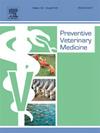Inter-laboratory evaluation of serological tests using Bayesian latent class models: A case study for bovine viral diarrhoea
IF 2.4
2区 农林科学
Q1 VETERINARY SCIENCES
引用次数: 0
Abstract
Accurate estimation of diagnostic test performance is crucial for epidemiological studies and disease control programs. Bayesian latent class models (BLCMs) provide a robust statistical approach to estimate these parameters in the absence of a gold standard test. This study aimed to establish a proof of concept for interlaboratory diagnostic test evaluation and to develop metrics for model fit validation, using serological detection of bovine viral diarrhoea as a case study. A total of 485 samples were collected from France, the Netherlands, Sweden and the United Kingdom and tested in four laboratories using six commercial ELISA kits. We initially fit a 6-test-4-population Hui-Walter model with both minimally informative and strong priors, as well as covariance terms. Model fit was assessed through four novel posterior predictive metrics, targeting the multinomial response frequency (LPmf), test-specific positivity (LPtp), pairwise crude agreement (LPag) and population-specific re-estimation of sensitivity and specificity (LRse/LRsp). BLCM results showed that almost all tests exhibited high sensitivity and specificity (>95 %). In addition, the model fit metrics identified one test breaching the assumption of constant test performance across populations which was therefore removed from the final model. This highlights the importance of robust model validation strategies to ensure reliable estimates. Our findings demonstrate that the joint evaluation of diagnostic tests across laboratories using BLCMs is both feasible and effective, providing robust accuracy estimates while reducing the burden on individual laboratories. As this approach does not require characterized samples, it is readily adaptable for evaluating diagnostics for emerging diseases without established gold standards.
使用贝叶斯潜类模型的血清学试验的实验室间评价:牛病毒性腹泻病例研究
准确估计诊断测试性能对流行病学研究和疾病控制计划至关重要。贝叶斯潜类模型(BLCMs)在没有金标准检验的情况下提供了一种稳健的统计方法来估计这些参数。本研究旨在建立实验室间诊断测试评估的概念验证,并以牛病毒性腹泻的血清学检测作为案例研究,开发模型拟合验证的指标。从法国、荷兰、瑞典和联合王国共收集了485份样本,并在4个实验室使用6个商用酶联免疫吸附试验试剂盒进行了检测。我们最初拟合具有最小信息量和强先验以及协方差项的6-test-4总体Hui-Walter模型。模型拟合通过四种新的后验预测指标进行评估,分别针对多项反应频率(LPmf)、测试特异性阳性(ltp)、两两粗一致性(LPag)和群体特异性敏感性和特异性重新估计(LRse/LRsp)。BLCM结果显示,几乎所有试验均具有较高的敏感性和特异性(>95 %)。此外,模型拟合指标确定了一个测试违反了跨种群恒定测试性能的假设,因此从最终模型中删除了该测试。这突出了鲁棒模型验证策略对于确保可靠估计的重要性。我们的研究结果表明,跨实验室使用blcm对诊断测试进行联合评估既可行又有效,提供了可靠的准确性估计,同时减轻了单个实验室的负担。由于这种方法不需要特征样本,因此很容易适用于在没有既定金标准的情况下评估新发疾病的诊断。
本文章由计算机程序翻译,如有差异,请以英文原文为准。
求助全文
约1分钟内获得全文
求助全文
来源期刊

Preventive veterinary medicine
农林科学-兽医学
CiteScore
5.60
自引率
7.70%
发文量
184
审稿时长
3 months
期刊介绍:
Preventive Veterinary Medicine is one of the leading international resources for scientific reports on animal health programs and preventive veterinary medicine. The journal follows the guidelines for standardizing and strengthening the reporting of biomedical research which are available from the CONSORT, MOOSE, PRISMA, REFLECT, STARD, and STROBE statements. The journal focuses on:
Epidemiology of health events relevant to domestic and wild animals;
Economic impacts of epidemic and endemic animal and zoonotic diseases;
Latest methods and approaches in veterinary epidemiology;
Disease and infection control or eradication measures;
The "One Health" concept and the relationships between veterinary medicine, human health, animal-production systems, and the environment;
Development of new techniques in surveillance systems and diagnosis;
Evaluation and control of diseases in animal populations.
 求助内容:
求助内容: 应助结果提醒方式:
应助结果提醒方式:


